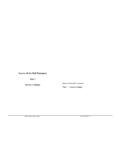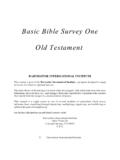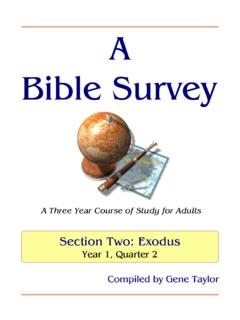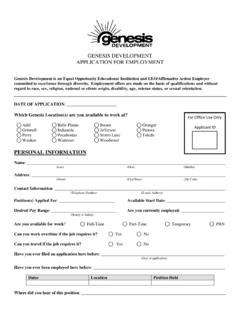Transcription of Old Testament Survey-Lecture Notes - Biblical Training
1 Biblical Training 0T500 Old Testament survey Douglas Stuart lecture Notes These Notes have been compiled from a series of lectures presented by Dr. Douglas Stuart. They do not represent actual class Notes written by Dr. Stuart. Old Testament survey Douglas Stuart Contents 1. Introduction . 4 I. Origins 2. genesis . 5- 6 3. Themes in genesis . 7 4. Exodus .. 8- 9 II. The Law 5. Law 10- 11 6. The Law: Covenant Structure 12- 13 7. The Law: Numerical Parallelisms . 14 8. The Law: Leviticus .. 15 9. The Law: Numbers . 16 10. The Law: Deuteronomy .. 17 III. The Promised Land 11. Joshua .. 18- 19 12. Holy War . 20 13. Judges .. 21- 22 14. The Promised land: Ruth .. 23 IV. The United Monarchy 15. 1 & 2 Samuel . 24- 26 16. Three Kings . 27 17. 1 & 2 Samuel, 1 Kings .. 28- 29 2 Old Testament survey Douglas Stuart V.
2 Poetry and Wisdom 18. Psalms .. 30- 31 19. Proverbs .. 32 20. Job 33- 34 21. Ecclesiastes 35 22. Song of Songs .. 36 VI. The Divided Monarchy 23. Prophetical Books 37- 39 24. Hosea, Amos, & Jonah . 40- 41 VII. Judah 25. 2 Kings . 42- 43 26. Historical Overview 44- 45 27. Isaiah, Micah, & Nahum . 46- 48 VIII. The Last Days 28. 2 Kings 22- 25 .. 49- 50 29. Jeremiah . 51- 52 30. Joel & Obadiah .. 53- 54 31. Habakkuk & Zephaniah . 55 IX. The Exile 32. Lamentations .. 56- 57 33. Ezekiel .. 58- 59 34. Daniel, Esther, & Isaiah . 60- 61 X. The Return 35. Background 62 36. Haggai & Zechariah . 63- 64 37. Malachi, Ezra, & Nehemiah 65- 66 3 Old Testament survey Douglas Stuart 1. Introduction a. This overview focuses on the content of each OT book and the corresponding events that give its context. The course is arranged (more or less) chronologically.
3 B. Time is not spent on introductory material- critical issues that are often debated such as authorship, dates, structure, etc. c. Extra time is spent on selected topics that Dr. Stuart feels warrant special attention or that may be missed on casual reading. He does not cover all chapters but expects the students will read the corresponding books in their entirety and are capable of seeing the main content for themselves. d. Suggested resources: i. New Bible Commentary, Carson ii. How to Read the Bible for All it's Worth, Fee & Stuart iii. International Standard Bible Encyclopedia iv. A Bible Dictionary 4 Old Testament survey Douglas Stuart 2. genesis a. Big Picture view of the content: i. Origins of the world ii. Origins of humanity iii. Origins of Israel (Note: most space given to this topic in genesis ) b.
4 Background i. Author: Moses (Wrote the entire Pentateuch) ii. Probably written around 1400 assuming early chronology iii. Written while Israel was still in the wilderness as Moses was leading a nation (ethnically mixed according to Exodus 12) in its early stages of infancy Recommended reading: Rethinking genesis by Dwayne Garrett c. Emphases found in genesis i. God's nature ii. God's purpose for the world iii. Why humans exists iv. The 1st Divine Covenants (the idea of extended kinship) v. The nature of sin and the perpetual corruption of human society vi. God's intolerance of sin vii. God's election of his people viii. God's plan of redemption ix. God works through sinful people d. Structure of genesis (Prologue followed by 10 origin accounts ( Hebrew- toledot) i. Prologue (1:1- 2:3) ii. The Account of the Heavens and the Earth (2:4- 4:26) iii.)
5 The Account of Adam's Descendants (5:1- 6:8) iv. The Account of Noah and his Family (6:9- 9:29) v. The Account of Shem, Ham, Japheth and their Descendants (10:1- 11:9) vi. The Account of Shem's Descendants (11:10- 26) vii. The Account of Terah's Descendants (11:27- 25:11) viii. The Account of Ishmael's Descendants (25:12- 18) ix. The Account of Isaac's Descendants (25:19- 35:29) x. The Account of Esau's Descendants (36:1- 37:1) xi. The Account of Jacob's Descendants (37:2- 50:26) Note the disproportionate amount of space given to Terah's descendants (the story of Abraham and Isaac); Isaac's descendants (the story of Jacob); and to Jacob's descendants (the story of Joseph). This makes it 5 Old Testament survey Douglas Stuart clear that Moses is emphasizing the nation of Israel as God's covenant people.
6 E. Additional Special Insights i. The prologue is a highly stylized overview of the creation account. It is tempting to read the 6 days as 6 successive stages of creation. However, close evaluation shows that it is really three stages. Day 4 corresponds to day 1; day 5 to day 2; and day 6 to day 3. God creates spaces and then fills those spaces. In essence, days 4, 5 &6 are a resumption of days 1, 2 & 3. This helps us understand that this account was not intended as a scientific explanation of how and when creation occurred. ii. Two main points to notice 1. God created everything (heaven and earth is a merism- see comments below) 2. He liked what he created (It was exactly as he intended) th iii. 7 Day of Rest 1. Obviously not needed by God but he does this as a basic example for his people to follow.
7 Iv. God created man in his image. The Hebrew word for image is tselem which means idol. An idol is a representation of someone. The concept of representation was well known to the ancient people. The original plan was that there would be no representation of God on earth other than man. Mankind was to be his representatives (idols). However sin interrupted the fulfillment of our intended purpose. Idol worship, which was almost universally practiced in that day, was a corruption of God's intention. v. The tree of the knowledge of good and evil Why wouldn't God want his people to discern good from evil? The term good and evil is a merism- an expression of opposites in order to describe completeness or everything in between. This is like saying I've searched high and low in place of saying I've searched everywhere.
8 Scripture says God has removed us from our transgressions as far as the east from the west (Psalm 103:12). This means he has completely separated us from our sins. In genesis 2:17, the knowledge of good and evil represents more knowledge than we can morally handle. Obtaining this knowledge necessarily takes us to a place of independence from God. It represents knowledge that God didn't intend for us. Hence the question, Who told you that you were naked? 6 Old Testament survey Douglas Stuart 3. Themes in genesis a. Gen 2:18 It is not good for man to be alone; I will make a helper suitable for him. Helper is Hebrew word- ezer. It means a source of help. The word translated suitable in some translations is the Hebrew word neged which means in front of or opposite to. It's the idea of corresponding to (according to Stuart).
9 This description doesn't denigrate women in any way. c. Gen 6:1- 3 The flood story is preceded by an unusual account about the sons of God seeing the daughters of man as beautiful and taking them as wives; bearing their children. The sons of God typically refers to angels. Stuart believes these are demon possessed men who had relations with women of the day. This is inserted in the narrative as a short sampling of how Satan's influence was manifested on earth, spreading evil. This is followed by the flood account which serves as a sampling of how God works throughout history. He will not tolerate sin forever. d. Gen 9:24 The curse of Ham is a curse against the sin of Ham and not a curse against a particular race. Ham uncovered the nakedness of his father means that he committed or at least came close to committing an incestuous act to his father.
10 This is later formally forbidden in God's moral law. e. genesis 1- 11 All of the history of the world is told in the 1st 11 chapters up to about 2000 BC. Then the story of Abraham begins which goes from chapter 12 to 24. More is written about Abraham than all of history preceding him. This represents a major slowing down of the narrative. It gives us an indication of the importance the book of genesis places on God choosing a covenant people to accomplish his plan. f. Gen 15 God appears to Abram and says I will be your shield which means, in effect, your boss. He goes on to say that your 4th generation will return to this land. The return will not take place until then because the iniquity of the Amorite (synonymous with Canaanite) is not yet complete. God once again demonstrates that he is long suffering with sin but will not tolerate it forever.







